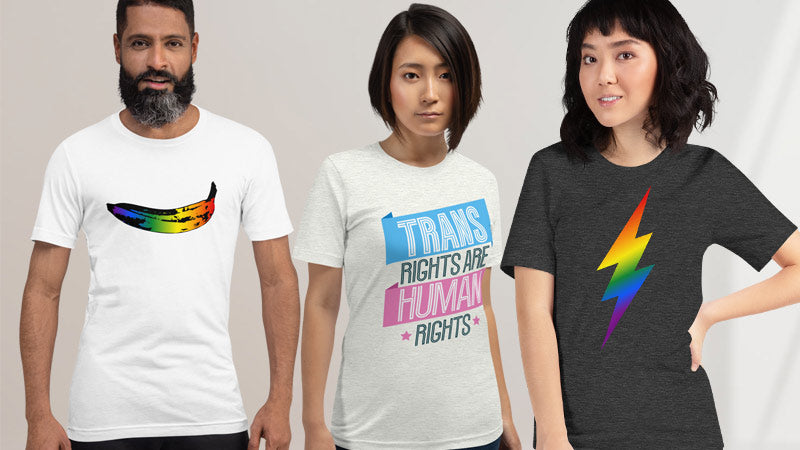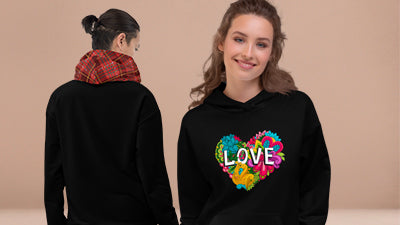What It Means To Be Non-Binary

Non-Binary identity is one of the most exciting and important cultural topics of the century so far. With celebrities such as Sam Smith, Bella Ramsey and Emma D’Arcy coming out as Non-Binary, explaining what Non-Binary means and proudly using they/them pronouns, mainstream representation of genderqueerness is shifting. With over an estimated 1.5 million Non-Binary people in the US alone, and with approximately a quarter of LGBTQ+ youth identifying as Non-Binary, no one can deny our existence anymore.
What is the Gender Binary?
The gender binary is conventionally understood as a categorisation that divides human beings into two groups – male and female. The first recorded instances of the gender binary were in Ancient Greece, and for thousands of years this binary has been used to enforce gender roles, expectations and stereotypes. For example, ‘masculinity was valued, and men should work and earn money,’ ‘femininity is denigrated, and women should have children, care for them, and look after the house.’
It’s important to note that many ancient and indigenous cultures accepted that many genders were possible. There are descriptions in the earliest documents of human history on tablets from Mesopotamia almost 4000 years ago, about people who were neither male nor female, detailing how they fit into society.
But in Western history the binary and binary genders prevailed, largely because it was enforced and propagated by both the Catholic and Protestant church. More recently, movements such as feminism challenged the rigidity of this system. And now, inspired by gender rule-breakers throughout history, people are questioning whether everyone has to fit into the binary at all. So it’s critical to understand that the gender binary is a construct.
OUR NON-BINARY COLLECTION view the full collection
What’s the Definition of Non-Binary?
If someone identifies as Non-Binary - sometimes shortened to Enby - it means that their gender manifests itself outside of the traditional binary of male and female. This could include feeling a mixture of male and female to varying degrees, or an absence of gendered feeling whatsoever. This identity can be stable or fluid, changing over time.
Some Non-Binary people also identify as Trans (as Non-Binary is a different gender to that assigned at birth), whereas others most definitely do not. Either way, Enby people are not Cisgender (when someone’s gender is the same as the one assigned at birth). The great thing about being Non-Binary is you can define it however you want. It is an umbrella term that encapsulates an entire galaxy of feeling.
How Does it Feel to Be Non-Binary?
Being Non-Binary feels different for everyone. There is no one size fits all explanation of the experience. And no right or wrong way. For some, it is a spiritual thing, exemplified by strong emotional connections to elements of masculinity, femininity, and/or androgyny.
For others, it is more precise and scientific, a practical definition that provides a solution to a large-scale societal problem (the lack of options caused by a strict gender binary).
It is a chance to be playful and experimental with gender. Some Non-Binary people, particularly artists and members of alternative subcultures, identify with non-human entities more than recognisably human genders. Think alien, monster, animal, plant, ethereal. There are literally no limits to how gender can feel and look when you’re Non-Binary!
Do You think You’re Non Binary?
It’s extraordinary how many people I’ve spoken to since coming out who’ve realised they’re Non-Binary too. First they approach me with curiosity. They ask me about how I feel, and my experience so far. I tell them that I don’t identify simply as a man or woman, that I feel like something else, just a person. That I would prefer if people used gender-neutral pronouns and terms for me.
And I can see something shift in their eyes. This is the missing piece they’ve been looking for in their journey of self discovery. They tell me that for years they’ve felt confused about their gender, that they never felt truly comfortable in it but weren’t aware there was another option. That’s how I felt throughout my teenage years. When I went to university and studied queer theory, and with the help of online resources, I finally found a term that describes how I feel.
If you think you might be Non-Binary, why not have a look at first-hand accounts on social media and YouTube, read memoirs such as A Year Without a Name by Cyrus Grace Dunham, and see if you relate to what they say?
Some friends have told me that they’re not sure if they can be ‘bothered’ to identify as Non-Binary. It’s not that they don’t feel that way, but that it seems like too much effort to tell people, to correct them when they use the wrong pronouns, to educate people who don’t understand. To this I would say: it’s worth it. Yes, it adds a bit of extra intellectual and emotional labour to your everyday life, but it’s a small price to pay for living authentically.
Some people have told me they relate to the definition of Non-Binary but feel they’re too old to use the label themselves. They see it as a Millennial / Gen Z invention, a part of youth culture. But there’s no age limit on being who you are. You’re never too old to be a man or a woman, so why should the same rules apply to identities outside the binary?
Types of Non-Binary Identity
Non-Binary: many people use this term, either as an umbrella term or its own identity.
Agender: identifying as having no gender, no connection to masculinity or femininity.
Androgyne: usually a mixture of masculine and feminine traits and expressions.
Multigender / polygender: experiencing more than one gender identity. This includes:
- Bigender (two distinct genders)
- Demigender (partly one gender and partly another, for example Demi-Boy or Demi-Girl)
- Pangender (multiple or all genders).
Gender Fluid: this well-known term means fluctuating between gender identities over time, for example feeling masculine one day and feminine the next.
Two-Spirit: A specific term used by some Native American people.
Transfeminine / Transmasculine: Some Non-Binary people use these terms to emphasise their transness and its direction, but many binary trans people also use these terms.
Non-Binary Pronouns
The most common gender-neutral pronouns are, of course, they/them/theirs. Third person singular ‘they’ has been used to refer to someone whose gender is unknown for hundreds of years.
Some Non-Binary people still use he/him/his and/or she/her/hers, or a mixture of pronouns such as she/they or he/they. Some people are open to all pronouns.
Some people prefer the more contemporary neopronouns. These include: ze/zir, xe/xem, sie/hir, e/em, ver/vir, it/its.
If you want to know someone’s pronouns just ask. You can do it by giving yours first, “Hi my name is Harper and my pronouns are they/them, what are yours”, or “what pronouns should I use for you.” But remember these are not ‘preferred’ pronouns. This is not an optional choice. These are that person’s identity. And if you misgender someone then stop, and apologise, and make sure you don’t do it again.
Understanding Gender Identity
Gender identity has been a hot topic for more than a decade. In reality, it is a simple concept: how a person’s gender feels on the inside. Whilst gender expression / gender presentation refer to external characteristics such as what you wear, how you cut your hair and if you put on makeup, gender identity is all about how you understand your gender in your brain, or your soul.
To Trans and Non-Binary individuals it makes perfect sense. I believe gender identity is a vital concept, one we should embrace and be free to explore. People should not be forced into a lifelong box of expectations determined by the biological sex they assigned at birth.
What Is Cisnormativity
This is a belief that everyone is cisgender, and it is impossible to identify as anything other than the gender you were assigned at birth. This is largely the territory of religious organisations, hate groups and right wing people.
Many conservatives want to shut down any discussion about gender identity, framing it as a dangerous thing which shouldn’t be taught to children in schools. This is just an attempt to prevent awareness amongst a generation so they can control them and feed them misinformation to drive fear.
They falsely claim that it’s an ideology in order to politicise it. We’ve seen this wave of right wing governments and political parties who have become opposed to gender identity. Usually driven by right wing fundamentalist religious organisations such as The Heritage Fund, who also oppose same sex marriage and women bodily autonomy. They espouse a ‘traditional family’ made up of a man and woman, effectively wrenching us back to the 1950s and before.
Gender Vs Sexual Orientation
Someone’s gender doesn’t always define their sexual orientation. Whilst cis men and women can identify as straight, gay, bi, pan, queer, or asexual, so can Non-Binary people. One of the wonderful things about Non-Binary thinking is the way it expands our understanding of sexuality in relation to gender.
Some recent terms have emerged that specifically refer to attraction to Non-Binary people. Ninsexual means attracted to people who are Non-Binary or neutral in gender. Saturnic refers to attraction to androgynous NB people. Triasexual is an attraction to any gender that falls under the NB umbrella. Ceteramoric or Terraic are terms for NB people who are exclusively attracted to other NB people.
It’s Enbian if they are also attracted to other genders as well. Enboric is an umbrella orientation that refers to anyone who is attracted, exclusively or otherwise, to NB people. If you’re NB and exclusively / primarily attracted to men, you may wish to identify as Viamoric. Feminamoric is the counterpart for women.
Non-Binary Vs Genderqueer
These are both umbrella terms that describe identities outside of the male/female binary. Genderqueer came earlier, first used in zines in the 1980s. Many people use the terms interchangeably. The only major difference is that some cis people may identify with Genderqueer due to their gender non-conformity, such as some butch lesbians or drag queens.













